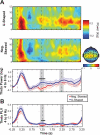Endogenous modulation of low frequency oscillations by temporal expectations
- PMID: 21900508
- PMCID: PMC3234094
- DOI: 10.1152/jn.00157.2011
Endogenous modulation of low frequency oscillations by temporal expectations
Abstract
Recent studies have associated increasing temporal expectations with synchronization of higher frequency oscillations and suppression of lower frequencies. In this experiment, we explore a proposal that low-frequency oscillations provide a mechanism for regulating temporal expectations. We used a speeded Go/No-go task and manipulated temporal expectations by changing the probability of target presentation after certain intervals. Across two conditions, the temporal conditional probability of target events differed substantially at the first of three possible intervals. We found that reactions times differed significantly at this first interval across conditions, decreasing with higher temporal expectations. Interestingly, the power of theta activity (4-8 Hz), distributed over central midline sites, also differed significantly across conditions at this first interval. Furthermore, we found a transient coupling between theta phase and beta power after the first interval in the condition with high temporal expectation for targets at this time point. Our results suggest that the adjustments in theta power and the phase-power coupling between theta and beta contribute to a central mechanism for controlling neural excitability according to temporal expectations.
Figures




References
-
- AEEGS American Electroencephalographic Society guidelines for standard electrode position nomenclature. J Clin Neurophysiol 8: 200–202, 1991 - PubMed
-
- Alegre M, Imirizaldu L, Valencia M, Iriarte J, Arcocha J, Artieda J. Alpha and beta changes in cortical oscillatory activity in a go/no go randomly-delayed-response choice reaction time paradigm. Clin Neurophysiol 117: 16–25, 2006 - PubMed
-
- Berens P. CircStat: A MATLAB toolbox for circular statistics. J Stat Software 31: 1–21, 2009
Publication types
MeSH terms
Grants and funding
LinkOut - more resources
Full Text Sources

